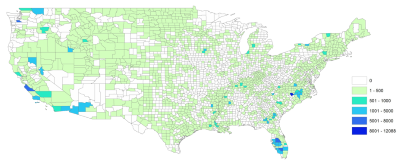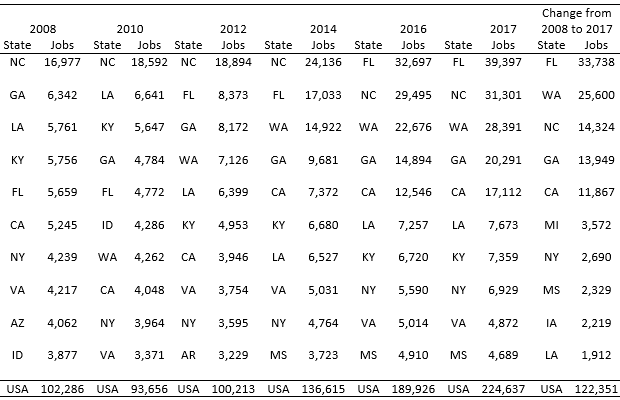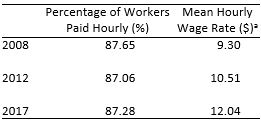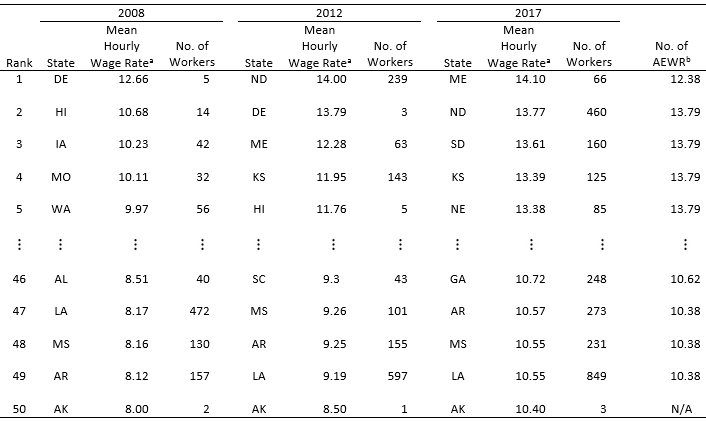
Shortages of seasonal labor in the agricultural sector have been a problem as far back as the 1940s. To address this labor scarcity, the United States and Mexico reached a formal agreement on seasonal farm labor in 1942 known as the bracero program.[1] This agreement helped resolve labor scarcity in U.S. agriculture and provided thousands of seasonal jobs to rural Mexicans. For 22 years, 2 million Mexican men worked on U.S. farms under this program, which ended in 1964 due to unjust labor practices (Onel and Farnsworth, 2016; Newman et al., 2018). The culmination of the bracero program signified the beginning of the flow of unauthorized migration, partly because of the end of U.S. farm employment for bracero workers. Returned workers assisted new migrants with crossing the border through their established networks. The H-2 temporary work visa program, which also had its genesis during World War II, was officially codified by the Immigration and Nationality Act of 1952, which combined all previous immigration and naturalization laws. The operation of H-2 was similar to the bracero program but without an inter-governmental agreement. Unlike the bracero program, the H-2 program was not terminated in the 1960s. Workers were brought through the H-2 program on a limited basis, primarily for work on apple farms in New York and sugarcane farms in Florida.
As labor-intensive agriculture—fruit and vegetable production—expanded, particularly in the western United States, labor shortages began to emerge, which created employment opportunities for Mexican workers. Increasing demand for farmworkers, the high cost of hiring H-2 workers, and the ease of crossing the border paved the way for unauthorized migrants to enter the United States. In the mid-1980s, the mistreatment of undocumented farm laborers and an increasing number of immigrant workers residing in the United States led to Congress passing the 1986 Immigration Reform and Control Act (IRCA). This act provided a one-time pathway to citizenship for the existing unauthorized workers and separated H-2 temporary work visas into two categories: H-2A for agricultural workers and H-2B for nonagricultural workers. This article explains how the H-2A program operates and highlights the importance of guest workers by examining their employment in various agricultural operations and states.
In the late 1980s and 1990s, more undocumented workers sought employment in agriculture.[2] The number of undocumented immigrants in the United States peaked at about 12 million in 2007 (Passel and Cohn, 2011, 2016). The unprecedented flow and number of undocumented workers have been intensively debated for the last two decades. As a result, Congress and several presidents have attempted to reform immigration policies but have not found common ground to pass immigration laws.[3] Instead, the U.S. Immigration and Customs Enforcement agency has intensified the enforcement of existing laws by deporting undocumented workers through domestic enforcement, and the U.S. Customs and Border Protection agency has apprehended unauthorized migrants through stricter border control. These heightened controls and the 2008 Great Recession reduced the number of unauthorized migrant workers, which have further exacerbated the ongoing farm labor shortages, particularly during peak demand. In recent years, farmers, seafood processors, and meat packers have petitioned the U.S. government to bring in more guest workers through the H-2A program to meet the labor shortages created by stricter enforcement of immigration policies.
Through the H-2A guest-worker program, agricultural employers can hire foreign workers for seasonal jobs using temporary work permits. Before hiring guest workers, employers have to prove that the employment is temporary or seasonal and that no qualified U.S. workers are available to perform the job. The employment of H-2A workers should not adversely impact wages and working conditions of U.S. workers (Farmworker Justice, 2018). Employers are also required to provide U.S. workers with the same amenities, such as free housing and transportation that are offered to guest workers.
For employers to hire guest workers under H-2A nonimmigrant classification, they must petition the U.S. Department of Labor (DOL) by (i) showing a temporary or seasonal job offer to foreign workers, (ii) proving that U.S. domestic workers are unavailable to perform seasonal and time-sensitive agricultural operations, (iii) demonstrating that hiring guest workers will not lower the prevailing wage rates and working conditions of U.S. domestic workers, and (iv) filing a H-2A petition with the DOL to obtain labor certification.
Hiring guest workers involves several steps and detailed paperwork.[5],[6] The first step, as indicated above, is that an employer must obtain a temporary labor certification for H-2A workers by petitioning the DOL. The second step requires, upon approval of labor certification, a petitioner to file Form I-129 with U.S. Citizenship and Immigration Services (CIS). The third step is for potential H-2A workers residing outside the United States to obtain an H-2A visa at a U.S. embassy or consulate abroad to enter the United States. Once the visa is issued, these workers can enter the United States and will be verified for H-2A authentication at a port of entry by U.S. Customs and Border Protection. If workers already have an H-2A visa, they can directly request admission to the United States through Customs and Border Protection. These steps—certification, Form I-129, and visa issuance—link employers and workers. The number of workers applied for by growers is generally more than the number of jobs certified, and the number of jobs certified is greater than the number of visas issued. Consequently, the actual number of workers employed is less than the number of workers applied for, jobs certified, and visas issued.
U.S. Citizenship and Immigration Services generally allows guest workers to stay up to the period authorized in the labor certification.[7] However, the period of stay may be extended one year at a time for a maximum of three years and must be supported by a new labor certification. A guest worker who exhausts the 3-year work permit must exit and reside outside the United States for three months before seeking new employment under the H-2A program. If workers leave the United States during their H-2A authorized period, the time spent outside the country will not count toward their 3-year limit.
The H-2A program requires considerable time and paperwork to find workers, even though hiring workers in a timely manner is critical to complete the seasonal tasks such as harvesting fruits and vegetables. Since this program mandates that employers provide free housing and transportation for H-2A workers, this additional cost can be too expensive for small- and medium-size farmers. Thus, guest workers are expensive and often viewed as a last source of labor. Moreover, the wage rate paid to guest workers is dictated by federal/state minimum wage, the prevailing wage rate, and the adverse effect wage rate (AEWR). The AEWR is the minimum wage that will not adversely impact the employment opportunities for U.S. workers. In a recent study, Devadoss and Luckstead (2018) found guest workers replace undocumented workers with a one-to-one ratio; consequently, the H-2A program does not depress the wage rate for undocumented workers. They also concluded that H-2A workers do not lower the wage rate for U.S. domestic workers, which is required under the H-2A program.
As of 2017, H-2A workers comprise 10% of the agricultural labor force (Martin, 2017b). Because of the progress made in streamlining the guest-worker program and the stricter domestic enforcement and deportation of undocumented workers, many producers rely on guest workers. Consequently, this group could reach 20% of the agricultural workforce in the next few years. Devadoss and Luckstead (2018) concluded that the H-2A program is more cost effective than stricter immigration policies to curb the number of undocumented workers through border surveillance and domestic enforcement. Their findings also showed that these latter immigration policies exacerbate the severe labor shortages faced by growers, while the guest-worker program provides a better alternative to meet the labor scarcity.

Source: Data for this figure were obtained from the U.S. Department
of Labor (2018).
Over the last few years, H-2A guest workers have become an increasingly important source of farm labor. This trend has been driven by the decreases in the number of undocumented workers due to the Great Recession and stricter enforcement of U.S. immigration policy. The number of H-2A certified jobs has risen, expanding by about 18% every year since 2014 and reaching 224,637 in 2017 (U.S Department of Labor, 2018). According to Devadoss and Luckstead (2018), the number of full-time equivalent farmworkers employed in 2016 was about 909,000, implying that H-2A certified jobs account for about 25% of total farmworkers. Figure 1 illustrates the concentration of H-2A certified jobs at the county level. Some counties in Florida, California, Arizona, North Carolina, Georgia, and Washington have applied for more certified jobs than other counties. Guest workers are more prevalent in the eastern and western part of the country, which grow more vegetables and fruits, than in the Midwest. Guest workers may migrate from state to state as work ends in a state. For example, a guest worker may harvest citrus in Florida, then move to North Carolina to pick berries and later to New York to harvest apples.

Notes: These data are from the U.S. Department of Labor (2018). The last column computes the
increase in the number of certified jobs from 2008 to 2017.
Table 1 presents the 10 leading states that apply for H-2A certifications, total certified jobs for the United States for even years from 2008 to 2016 and for 2017, and the change in the number of certifications between 2008 and 2017. As this table reveals, North Carolina was the leading state in certified jobs from 2008 to 2015, with considerably more than any other state. In the last two years, Florida surpassed North Carolina in the total number of H-2A jobs certified, and Washington, Georgia, and California have consistently ranked third, fourth, and fifth, respectively, since 2014.
Even though Florida and Washington were not among the top three states in applying for guest workers in 2008, they were the leading states in 2017. The increases in the number of guest-worker jobs certified in these two states are the largest: 33,738 for Florida and 25,600 for Washington. Because these two states rank third and second in labor-intensive fruit and nut production (U.S. Department of Agriculture, 2018) and they are not border states—where undocumented labor tends to be higher (Pew Research, 2016)—they apply for more guest workers than border states such as California and Texas. North Carolina, Georgia, and California also rank among the top five states in the growth of applications for guest workers from 2008 to 2017.
According to the 2012 Agricultural Census, though North Carolina ranked only tenth at 2.5% in the total value of vegetable production (U.S. Department of Agriculture, 2018),[8] a highly labor-intensive segment of agriculture, this state accounted for 18.5% of all H-2A certified jobs in that year. North Carolina farmers recognized early on that hiring foreign workers through the H-2A program was expensive, with onerous paperwork (Clemens, 2013), leading them to establish the North Carolina Growers Association in 1989 to facilitate the H-2A application process and legal compliance. This association was established three years after the H-2A guest-worker program was classified from H-2 by the 1986 IRCA and is consistently the largest applicant for H-2A workers in the nation, accounting for about 40% of all H-2A workers in North Carolina in 2012. Consequently, North Carolina farmers have had greater access to guest workers (Clemens, 2013). This corroborates the findings of Charlton, Castillo, and Hertz (2018), who shows that pooling the effort to acquire H-2A workers through farm labor contractors and employer organizations is key to reducing costs and paperwork.
While North Carolina established the growers’ association to assist with hiring H-2A workers, Florida growers relied more heavily on domestic and undocumented workers until recent years (Onel and Farnsworth, 2016). With an inadequate supply of seasonal labor and the labor shortage only worsening with stricter immigration policies, Florida growers have followed North Carolina’s approach by expanding the use of farm labor contractors to employ H-2A workers for citrus production (Onel and Farnsworth, 2016; Martin, 2017a; Florida Fruit &Vegetable Association, 2018). With a large labor-intensive agricultural sector, Florida has surpassed North Carolina in applying for H-2A certification. About 85% of the H-2A workers in Florida are employed by citrus growers, and the remaining guest workers are employed in other fruit and vegetable cultivation.
Among the leading 10 states that employ guest workers, seven of them (North Carolina, Florida, Georgia, Louisiana, Kentucky, Virginia, and Mississippi) are southeastern states that do not share a border with Mexico. In contrast, border states such as California (the leading producer of fruits and vegetables) and Texas employ considerably fewer guest workers, likely for two reasons: Farmers in these states employ more undocumented workers,[9] and a large portion of legal immigrants working in agriculture reside in these states (U.S. Census Bureau, 2017). Consequently, the demand for guest workers by agricultural producers in these states is considerably less. Washington, a leading producer of apples and other fruits, ranks third in recent years in employing guest workers, while New York is consistently among the top 10 states in hiring guest workers because of its large dairy sector.

Notes: These data are from the U.S. Department of Labor (2018).
a Workers under the category “Other” perform a variety of farm activities ranging from general farm, nursery, greenhouse,
Christmas trees, agricultural equipment operators, …, grass turf work.
This section examines the number of certified guest-worker jobs in major agricultural sectors nationally and among the leading five states (as shown in the first column of Table 2). Nationally, for both 2016 and 2017, the Fruits & Nuts segment applied for the most guest workers, followed by Vegetables; Grains & Row Crops; Other (these farm activities cover general farm, nursery, greenhouse, Christmas tree, agricultural equipment operation, grass turf work, etc.), and finally Meat & Dairy. Between 2016 and 2017, the number of jobs certified nationally expanded by only 487 (or 5%) for Meat & Dairy but by 21,899 (or 37.7%) in Fruits & Nuts.
While the number of certified guest-worker jobs expanded nationally for all five categories, this is not the case in the top five states. In Florida, the majority of guest workers are employed in fruit and nut cultivation because of the large citrus industry; however, between 2016 and 2017, H-2A workers moved from fruit and nut cultivation to vegetable production (as reported in the FL columns of Table 2). This shift was likely due to citrus greening, which damaged the trees and reduced production; as a result, many farmers have switched to crops such as artichokes, hops, etc. (Murphy, 2017). In North Carolina, while Grain & Row Crops employed the most H-2A workers, the Fruits & Nuts segment experienced an expansion while Vegetables and Grain & Row Crops faced a contraction in H-2A employment (NC columns in Table 2). Washington, a primarily fruit- and nut-growing state, increased employment of guest workers in this segment from 2016 to 2017 (WA columns in Table 2). In California, growth in guest workers primarily came from Fruit & Nut and Vegetable cultivation (CA columns in Table 2). The top five states that used the H-2A program employ no or very few guest workers in Meat & Dairy.

Notes: These data are from U.S. Department
of Labor (2018).
a Calculated as a national average of the wage
rates of all H-2A workers.
As shown in Table 3, 87% of workers are contracted for hourly work and paid hourly wage rates, which remained stable over the last 10 years, and the remaining guest workers have weekly, bi-weekly, and monthly contracts. The second column of Table 3 shows that the hourly wage rate rose from $9.30/hour in 2008 to $12.04/hour by 2017, a 29.50% increase.
Table 4 reports hourly wages for the top and bottom five states and the number of guest workers in these states. While the states in the top five are generally in the Northeast and Midwest (particularly in 2012 and 2017), the states in the bottom five are generally in the South. In 2008, Delaware and Hawaii had the highest average wage rates, at $12.66/hour and $10.68/hour, while Arkansas and Alaska had the lowest, at $8.12/hour and $8.00/hour. In 2012, North Dakota and Delaware led the country in paying guest workers $14.00/hour and $13.79/hour, while Louisiana and Alaska paid the lowest wages, at $9.19/hour and $8.50/hour. The highest wage rate in North Dakota is likely due to the demand for labor arising from the oil boom (Wegmann, 2014). In 2017, Maine and North Dakota had the highest average wages, at $14.10/hour and $13.77/hour, while Louisiana and Alaska had the lowest wages, at $10.55/hour and $10.40/hour. The minimum wages paid to guest workers are above the federal minimum wages of $6.55/hour in 2008 and $7.25/hour in 2009. A comparison of the guest-worker wage rates to AEWR (Newman et al., 2018) shows that guest workers are generally paid near or above the AEWR for most states, which is in line with government requirement that domestic workers should not be adversely impacted by the H-2A program. However, in some states, guest worker wage rates are slightly below the AEWR in 2017, as reported in Table 4.

Sources: a U.S. Department of Labor (2018).
b Newman et al. (2018).
Nationally, guest workers’ hourly wage rate for 2017 was fairly similar across different agricultural sectors, with the highest average hourly wage rate of $12.01/hour for Meat & Dairy and the lowest wage rate of $11.37/hour for Grains & Row Crops (U.S. Department of Labor, 2018).
This article reviews the H-2A program, practical issues and difficulties in hiring guest workers, and trends in certified H-2A workers and wages paid. In doing so, it highlights the importance of guest workers for U.S. agriculture, particularly for labor-intensive sectors. Labor scarcity in the U.S. farm sector is a perpetual problem and the H-2A program helps to fill the labor shortages. Although the process of hiring H-2A workers has become easier, further streamlining the H-2A program would assist farmers to facilitate the hiring process for timely agricultural operations, which would mitigate crop losses experienced by farmers. Furthermore, as observed by Devadoss and Luckstead (2018), a better functioning H-2A program is considerably less expensive than immigration control policies. It will also provide an incentive for employers to secure more guest workers, which not only addresses labor shortages but also lessens the incentives for unauthorized entry.
Charlton, D., M. Castillo, and T. Hertz. 2018. “Explaining the Growth in Agricultural Guestworker Demand.” Paper presented at the annual meeting of the Agricultural and Applied Economics Association, Washington, DC, August 5–7
Clemens, M.A. 2013. International Harvest: A Case Study of How Foreign Workers Help American Farms Grow Crops and the Economy. Technical report, Partnership for a New American Economy and the Center for Global Development.
Devadoss, S., and J. Luckstead. 2018. “US Immigration Policies and Dynamics of Cross-Border Workforce in Agriculture.” World Economy 41:2389–2413.
Florida Fruit & Vegetable Association. 2018. Labor. Florida Fruit & Vegetable Association. https://www.ffva.com/FFVA/Services/Labor/FFVA/_Services/Labor.aspx [Accessed on 3/8/2018].
Farmworker Justice. 2018. “H-2A Guest Worker Program.” Farmworker Justice. Available online: https://www.farmworkerjustice.org/content/h-2a-guestworker-program/ [Accessed July 10, 2018].
Martin, P. 2017a. The H-2A Farm Guest Worker Program Is Expanding Rapidly: Here Are the Numbers You Need to Know. Washington, DC: U.S. Department of Agriculture, National Agricultural Statistics Service. Available online: https://www.epi.org/blog/h-2a-farm-guestworker-program-expanding-rapidly/ [Accessed April 10, 2018].
Martin, P. 2017b. “Trump, Immigration, and Agriculture.” Choices 32(1).
Murphy, M.J. 2017, June 15. “Citrus Greening: Will a Signature Industry for Florida Survive?” Orlando Sentinel.
Newman, E., B. Goldstein, A. DerVartanian, W. Wang, V. Ruiz, and J. Felix-Romero. 2018. No Way to Treat a Guest: Why the H-2A Agricultural Visa Program Fails US and Foreign Workers. Technical report, Farmworker Justice. Available online: https://www.farmworkerjustice.org/sites/default/files/documents/7.2.a.6%20fwj.pdf [Accessed on July 16, 2018].
Onel, G., and D. Farnsworth. 2016. Guest Workers: Past, Present and the Future. Technical report, Citrus Extension Trade Journals, University of Florida, UF/IFAS Citrus Extension.
Passel, J.S., and D. Cohn. 2011. Unauthorized Immigrant Population: National and State Trends, 2010. Washington, DC: Pew Research Center.
Passel, J.S., and D. Cohn. 2016. Size of U.S. Unauthorized Immigrant Workforce Stable after the Great Recession. Washington, DC: Pew Research Center.
Pew Research Center. 2016. U.S. Unauthorized Immigration Population Estimates. Washington, DC: Pew Research Center.
Rural Migration News. 2018. “H-2A Program Continues to Expand.” Rural Migration News. Available online: https://migration.ucdavis.edu/rmn/blog/post/?id=2161 [Accessed May 10, 2018].
U.S. Census Bureau. 2017. American Community Survey. Washington, DC: U.S. Census Bureau. Available online: https://www.census.gov/programs-surveys/acs/ [Accessed June 13, 2017].
U.S. Citizenship and Immigration Service. 2018. H-2A Temporary Agricultural Workers. Washington, DC: U.S. Citizenship and Immigration Service. Available online: https://www.uscis.gov/working-united-states/temporary-workers/h-2a-temporary-agricultural-workers [Accessed March 15, 2018].
U.S. Department of Agriculture. 2018. Quick Stats. Washington, DC: U.S. Department of Agriculture, National Agricultural Statistics Service. Available online: https://quickstats.nass.usda.gov/?source_desc=CENSUS [Accessed April 10, 2018].
U.S. Department of Labor. 2018. Foreign Labor Certification: OFLC Performance Data. Washington, DC: U.S. Department of Labor, Employment & Training Administration, Office of Foreign Labor Certification. Available online: https://www.foreignlaborcert.doleta.gov/performancedata.cfm [Accessed March 15, 2018].
Wegmann, P. 2014, June 10. “Why One Walmart in North Dakota is Paying $17.40 an Hour.” Daily Signal.
[1] Newman et al. (2018) provide a detailed discussion of the success and failure of the bracero program.
[2] Hotel, construction, service, and meat-packing sectors in the United States also have increasingly employed undocumented workers.
[3] However, many states (e.g., Arizona, Alabama, and Georgia) passed state-level laws to curb the employment of undocumented workers.
[4] The following discussion is drawn largely from the US Citizenship and Immigration Service (U.S. Citizenship and Immigration Service, 2018).
[5] Since the paperwork requires considerable detail, it created new business for attorneys, law firms, and labor contractors specializing in hiring and labor relations, and their services are increasingly utilized by the growers and their associates to ease the hiring process.
[6] See Charlton, Castillo, and Hertz (2018) for a detailed schematic explanation of this process.
[7] According to Rural Migration News (2018), H-2A workers typically stay less than the maximum allowable duration of 10 months.
[8] For comparison, California, Florida, and Washington State ranked first, second, and third at 38.6%, 8.2%, and 6.4%, respectively, of the total value of vegetable production.
[9] According to the Pew Research Center (2016), California employs 2.35 million or 21% of undocumented workers and Texas employs 1.65 million (12%).